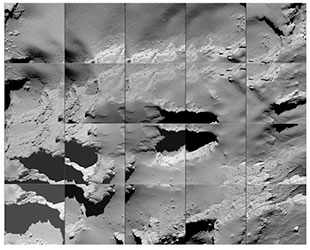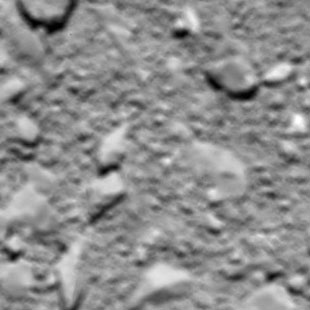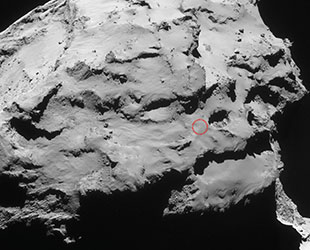Sept. 30, 2016 — The first spacecraft to orbit a comet and deploy a lander to its surface came to its end Friday (Sept. 30) with its own controlled impact on the dusty-icy body.
The European Space Agency's Rosetta probe descended to a pitted region of Comet 67P/Churyumov-Gerasimenko, bringing its 12.5-year journey to a finish. The mission was ended due to the spacecraft's increasing distance from the sun, reducing the available solar power needed to operate it and its instruments.
Confirmation of the mission's end came from the European Space Agency (ESA) control room at 7:19 a.m. EDT (1119 GMT). It took 40 minutes for the last signal from the probe to reach Earth.
"I can announce the full success of this historic descent of Rosetta towards 67P. I declare hereby mission operations ended for Rosetta," Patrick Martin, ESA's Rosetta mission manager, said. "Flying to a comet and around a comet for over two years as close as a few kilometers and more than 500 million kilometers from Earth is a challenge and we've done it."

Sequence of images captured by Rosetta during its descent to the surface of Comet 67P/Churyumov-Gerasimenko. (ESA) |
The Rosetta orbiter arrived at the comet on Aug. 6 2014, after a ten-year voyage through the solar system following its launch on March 2, 2004. It deployed its lander, named Philae, to the surface of Comet Churyumov-Gerasimenko eight months later on Nov. 12, 2014.
Rosetta then spent two years circling the comet, returning an unprecedented amount of data as 67P made its closest approach the sun. The probe also acted as a relay for the time (about 60 hours) that the Philae lander was active on the surface.
Rosetta's end began on Saturday (Sept. 24), as its flight controllers began commanding a series of maneuvers to line it up for its final, fateful drop. A last, 3-minute thruster firing on Thursday put the spacecraft on a 12-mile (20 km) course to collide with the comet.
According to ESA, calculations predicted Rosetta's impact speed to be roughly walking pace, about 3 feet per second (90 m/s) or about the same speed as Philae hit the surface back in 2014.

Rosetta's last image of Comet 67P, taken shortly before impact at an altitude of 65 feet (20 meters) above the surface. (ESA) |
Even in its final hours, Rosetta continued to collect first-of-their-kind measurements, including analyzing gas and dust closer to a comet's surface than ever possible before and taking high-resolution images of the nucleus. The images included views of open pits of the Ma'at region, a smooth ellipse on the "head" of the double-lobed comet, where the spacecraft made its controlled impact.
Ma'at is home to several active pits more than 330 feet (100 m) in diameter and 160 to 200 feet (50 to 60 m) deep. The walls of the pits exhibit lumpy structures about 3 feet wide (1 m), called "goose bumps," which are thought to be the signatures of cometesimals that assembled to form the comet in the early phases of solar system formation.
Rosetta was not designed to land and so ESA's flight team had to suppress some of its systems to avoid it entering a "safe mode" on the way in. Then, it needed a means to be turned off, less it continue to transmit random signals that could interfere with other missions' spacecraft.
To achieve the shutdown, some of Rosetta's status checks were configured to trigger a special mode last used during its pre-launch testing on Earth, "pacifying" the probe.
Over the past 12.5 years, the Rosetta spacecraft traveled more than 4.9 billion miles (7.9 billion km). On Friday, the probe was 450 million miles (720 million km) from Earth.

Image taken with Rosetta's NavCam on Sept. 21, 2014 showing the Ma'at region (circled in red) where the mission ended. (ESA) |
The Rosetta mission carried a payload of 11 instruments, including three provided by NASA. As the first spacecraft to rendezvous with and orbit a comet, it made a number of science discoveries, including that the water on the comet was substantially different from the water on Earth (in the ratio of deuterium to hydrogen); that the surface was rich with organic compounds; and that molecular oxygen is in the gas that streams off the comet.
The mission got its name from the Rosetta Stone that led to deciphering Egyptian hieroglyphics. Similarly, Rosetta's scientists hoped that the spacecraft would unlock how the solar system evolved.
"The Rosetta Stone was originally located in Sais and we shall name the impact point as such so that we can finally say that Rosetta has come home," stated Martin. "Farewell Rosetta, you've done the job that was space science at its best."
